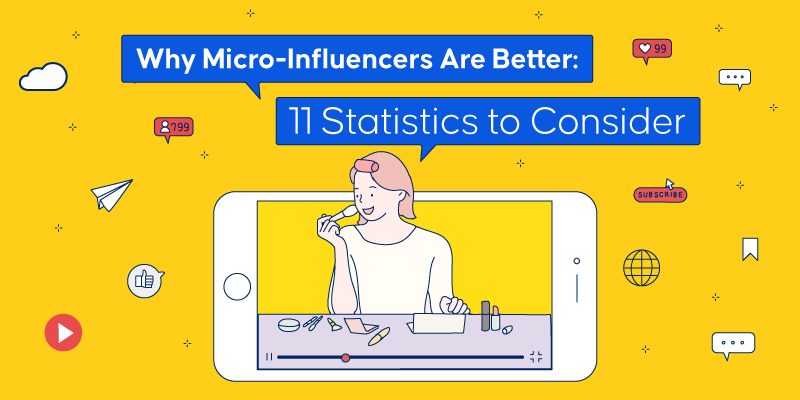Influencer marketing has become a significant by-product of the social media age as consumers steadily grow desensitized to traditional advertising.
However, influencer marketing’s sharp rise also has its fair share of potential drawbacks, namely, consumers growing increasingly tired of sponsored posts constantly displayed on their feeds. This phenomenon is known as influencer fatigue.
Fortunately, working with micro-influencers, those with niche social followings ranging from 10K to 100K, is an excellent way for brands to combat influencer fatigue while still reaching their target audience and getting a better ROI.
Let this infographic serve as your comprehensive visual guide regarding why micro-influencers are better than macro-, mega-, and even celebrity influencers in certain situations.

Also Read: Micro-Influencers: Business Boosters
Micro-Influencers: Why Is Smaller Better?
Working with “bigger” influencers like mega- or macro-influencers doesn’t necessarily mean better or equal success. Sometimes, smaller-scale creators can be the perfect partner for your unique situation. Here’s a comparison to illustrate why.
Cost
As an influencer gains a more significant following, working with them will be more costly. With a hefty price tag attached to macro-, mega-, and celebrity influencers, companies with limited budgets often have to invest most of their resources in just one piece of content.
While the initial buzz around your product or service will be more substantial, you will reach fewer people long-term, thus limiting your brand’s ROI. Fortunately, micro-influencers with a smaller following are more affordable, giving your small or medium-sized business much-needed flexibility.
In addition, since micro-influencers are still growing their audience, they sometimes tend to be more active and overdeliver in partnerships, which bodes well for your organization.
Demand
The law of supply and demand states that when a commodity exceeds supply, its value or price naturally increases, and enlisting the help of more prominent influencers isn’t any different.
Many companies would attempt to get in touch with these famous influencers and secure their services for advertising or promotional collaborations. With many pining for the opportunity to work with these public figures, it is more difficult for SMEs to talk, negotiate, and partner with them, even if they’re willing to spend the resources.
On the contrary, while micro-influencers attract considerably less interest since they’re still growing their fanbase, that’s not to say they can’t still have a sizeable impact on helping your business. Less demand for these smaller creators means they’ll be more willing to work with you and even go above and beyond when it comes to reaching your objectives.
Authenticity and Audience Relationship
Another noteworthy downside of getting more successful influencers to represent or endorse your brand is the possibility of your audience viewing them as inauthentic. The more brand deals and sponsored posts macro- or mega-influencers take on, the more likely their audience’s perception of them may change.
Some may view these partnerships as merely earning opportunities, not products or services that the influencer believes in and uses. While micro-influencers have fewer chances than mega-influencers to secure brand deals or sponsorships, they benefit from an invested audience that supports them and is more willing to try the products or services they endorse.
Additionally, if you’re targeting a specific demographic, finding the right influencer in that community can further boost your influencer marketing efforts.
Engagement
One would think that a more popular influencer would have more consistent engagement compared to their smaller counterparts. However, that’s not necessarily the case. In recent studies, micro-influencers have shown to have considerably more engagement with their small audience than more prominent influencers across multiple platforms.
Micro-influencer engagement rates and traffic remain consistent despite having a smaller audience because they bridge the gap between a public personality and a relatable individual. Since they have a considerably smaller following, their interactions with their audience are often more well-thought-out, personalized, and genuine.
This relatability leads micro-influencer followers to value their insights and opinions regarding the content and products they showcase on their social media accounts.
Micro-influencer Statistics
Market Share
- 47.3% of all creators are micro-influencers, the largest group among all tiers. Meanwhile, celebrities, macro-, and mega-influencers account for only 0.5-6.5% of all content creators.
- In 2021, micro-influencer market shares saw a 2% increase, going from 89% to 91%. This figure showcases the dominance of micro-influencers in content creation compared to far more recognizable names within the medium.
Demand
You may be surprised to discover that micro-influencers are treading upward compared to more prominent influencers, which are seeing a significant dip in popularity over the past few years. Annual surveys often boast positive results for micro-influencers. However, 2021 saw substantial strides in micro-influencers impacting different metrics, especially regarding demand.
- 90% of surveyed marketers claim they prefer working with micro-influencers, a 10% increase from the previous year, which boasted an already impressive 80% in 2020.
- In the same survey, only 14% of marketers preferred celebrity influencers, an 8% decrease in only one year.
- By 2023, experts predict that expenditures related to influencer marketing in the U.S. alone will reach $4.5 billion.
Cost
- Micro-influencers charge between $100-$500 per Instagram post. In comparison, Macro- and mega-influencers charge a minimum of $5,000 to upwards of $10,000 or more for a single Instagram post.
Engagement
- Experts claim that a micro-influencer engagement rate of 2-3% is ideal when securing or negotiating a partnership with a micro-influencer.
- Micro-influencers participate in “buying conversations” that include product recommendations 22.2 times more than the average consumer weekly.
As you can see in the chart below, micro-influencers boast higher engagement rates than mega-influencers across various popular social media platforms.
| Platform | Average Micro-Influencer Engagement Rate | Average Mega-Influencer Engagement Rate |
| 3.86% | 1.21% | |
| YouTube | 1.64% | 0.37% |
| TikTok | 17.96% | 4.96% |
Micro-influencer ROI
Micro-influencer-posted images convert over 20%, 7% more than the industry average than macro-influencers.
Credibility
Per surveys, 82% of consumers stated that they are likelier to follow a micro-influencer recommendation than more prominent influencers.
As you can see from these statistics, today’s marketing industry relies more on influencers’ power, influence, and reach than in years past. While traditional marketing, like television ads, billboards, and other recognizable advertising, still has its place, influencer marketing will most likely join them in the upcoming years as one of the more prominent marketing strategies.
The Impact of Micro-influencers
The current marketing landscape has steadily evolved over the past decade. Once viewed as niche celebrities, influencers or content creators are now a cornerstone of effective social media marketing services.
While influencer marketing still has room to grow before the strategy becomes the norm and not the exception, it’s a method worth exploring now, especially enlisting micro-influencers help.
Now that you know why micro-influencers are better in certain situations, you can use this insight to create a better approach when utilizing influencer marketing. Keep these statistics in mind as you employ micro-influencers to help you in your different marketing endeavors.
If you’re looking for a reliable digital marketing agency to partner with, consider Spiralytics Inc. Providing unparalleled digital marketing services since 2013, Spiralytics is a rapidly growing company in the Philippines and the U.K.
Our team has a wealth of experience using data analytics and a performance-based approach
to digital marketing to help global brands and some of the biggest companies in the Philippinesachieve spectacular results. Contact us today and help us help you.






